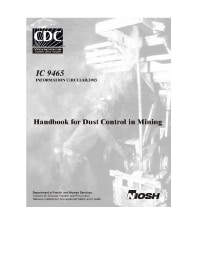Mining Publication: Handbook for Dust Control in Mining
Original creation date: June 2003
Authors: FN Kissell
NIOSHTIC2 Number: 20023262
U.S. Department of Health and Human Services, Public Health Service, Centers for Disease Control and Prevention, National Institute for Occupational Safety and Health, DHHS (NIOSH) Publication No. 2003-147, Information Circular 9465, 2003 Jun; :1-131
This handbook describes effective methods for the control of mineral dusts in mines and tunnels. It assumes the reader is familiar with mining. The first chapter deals solely with dust control methods, regardless of the application. It is a brief tutorial on mining dust control and will be of help to the reader whose dust control problem does not conveniently fit any of the mining equipment niches described in later chapters.
The subsequent chapters describe dust control methods for different kinds of mines and mining equipment. This includes underground coal and hard-rock mines, as well as surface mines, stone mines, and hard-rock tunnels. Because dust sampling has so many pitfalls, a chapter on methods used to sample dust is included. For those occasions when there is no practical engineering control, a chapter on respirators is also included.
Except for those listed as "future possibilities" in the longwall chapter, the dust control methods described are practical and cost-effective for most mine operators.
If controlling dust were a simple matter, dust problems in tunnels and mines would have been eradicated years ago. Unfortunately, most underground dust control methods yield only 25% to 50% reductions in respirable-sized dust. Often, 25% to 50% reductions are not enough to achieve compliance with dust standards. Thus, mine operators must use several methods simultaneously, usually without knowing for sure how well any individual method is working. In fact, given a 25% error in dust sampling and day-to-day variations in dust generation of 50% or more, certainty about which control methods are most effective can be wanting. Nevertheless, over the years, some consensus has emerged on the best dust control practices. This handbook summarizes those practices.

NIOSHTIC2 Number: 20023262
U.S. Department of Health and Human Services, Public Health Service, Centers for Disease Control and Prevention, National Institute for Occupational Safety and Health, DHHS (NIOSH) Publication No. 2003-147, Information Circular 9465, 2003 Jun; :1-131